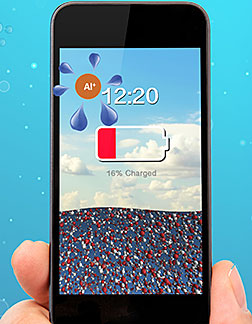- Number 417 |
- July 7, 2014
Satisfying metals' thirst vital for high-capacity batteries

Satisfying metals' thirst vital for
high-capacity batteries
Imagine a cell phone battery that worked for days between charges. At DOE’s Pacific Northwest National Laboratory, scientists are answering fundamental science questions that could make batteries work more efficiently. Replacing lithium, which is in the +1 oxidation state, with metals that can carry multiple charges could potentially increase battery capacity.
"Our initial efforts focused on understanding the behavior of metals that have +2 or +3 oxidation states in an aqueous solution," said Dr. Sotiris Xantheas, who led the research at PNNL. "This would double or triple the amount of charge that could be stored in a battery, but before this study, we had no insights on how the charge on the ions is either stabilized or destabilized when their local environment changes."
A roadblock to this future is understanding how to keep multiply charged ions stable with respect to hydrolysis channels.
When a multiply charged ion, such as aluminum (Al+3), encounters a single water molecule, the result can be explosive. The metal ion rips an electron from the water molecule, causing a molecular-level explosion due to Coulombic forces. But multiply charged metal cations exist in water in countless ways, such as the calcium ions in your chocolate milkshake.
The PNNL scientists, post-doctoral fellow Evangleos Miliordos and Laboratory Fellow Sotiris Xantheas, determined the paths that lead to either the hydrolysis of water or the creation of stable metal ion clusters peaceably surrounded by water. It comes down to the pH of the solution, the number of water molecules nearby and the energy needed to remove electrons from the metal, known as the ionization potential.
This research was featured on the cover of Physical Chemistry Chemical Physics and in a special issue of Theoretical Chemistry Accounts dedicated to Prof. Thomas H. Dunning, Jr. on the occasion of his 70th birthday.
"This paper describes an elegant use of computational modeling to understand a phenomena that is of fundamental importance in chemistry, yet has many practical applications as well," said Dunning, co-director of the Northwest Institute for Advanced Computing, operated by PNNL and the University of Washington.
What's next? The researchers are now working to extend their computational protocol to the solution phase and at interfaces. Extending the methodology will allow the team to better understand the dynamic interactions occurring, eventually leading to better battery technologies.
This research was sponsored by DOE’s Office of Basic Energy Sciences, Chemical Sciences, Geosciences, and Biosciences Division. Resources at the National Energy Research Scientific Computing Center were used.[Kristin Manke, 509.372.6011,
kristin.manke@pnnl.gov]
